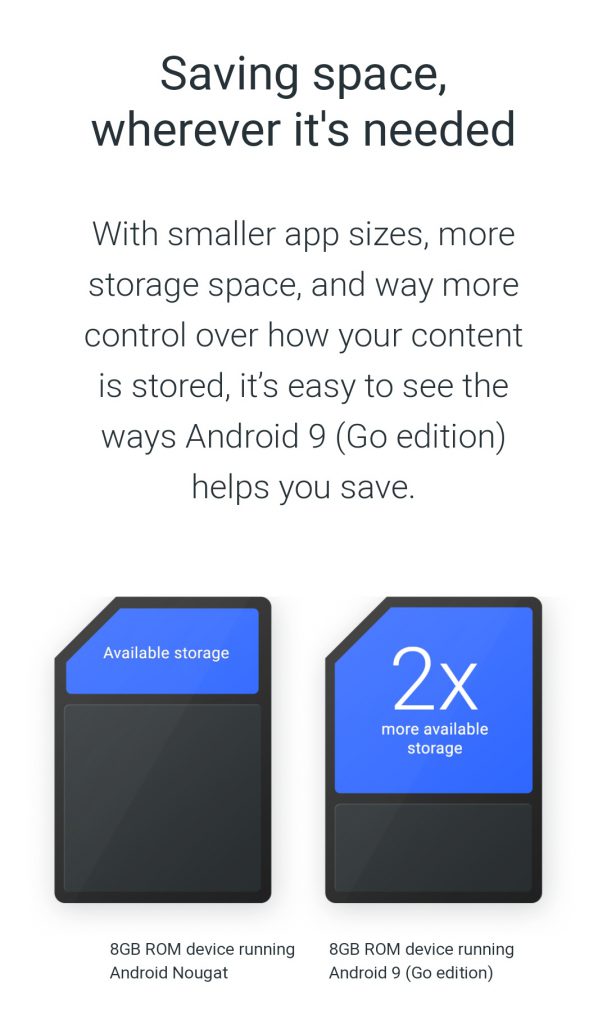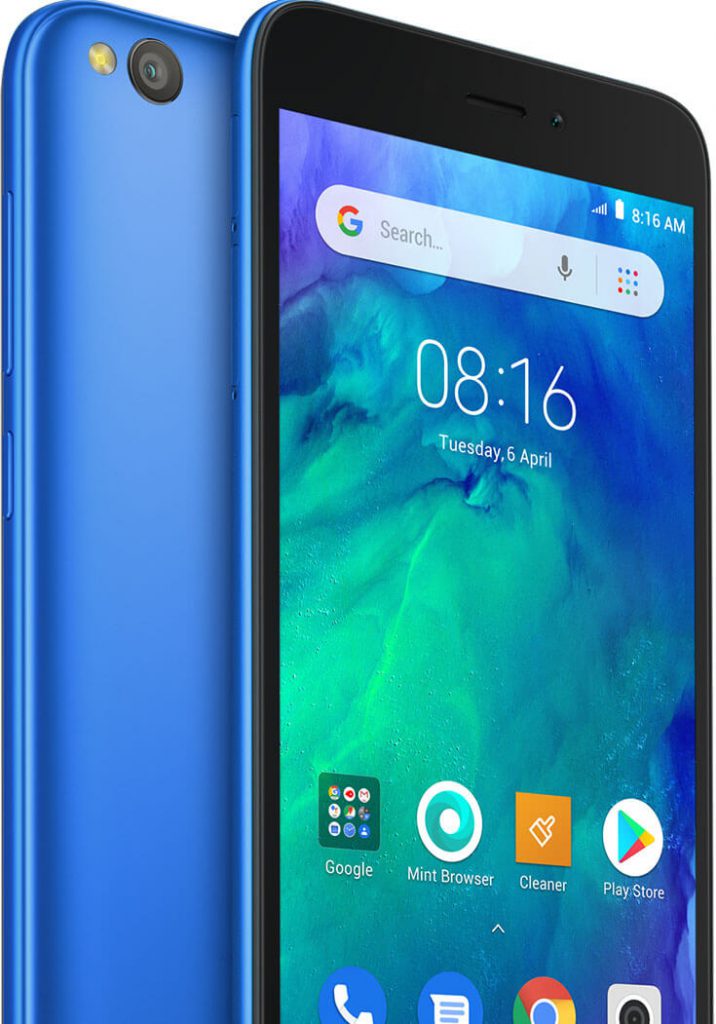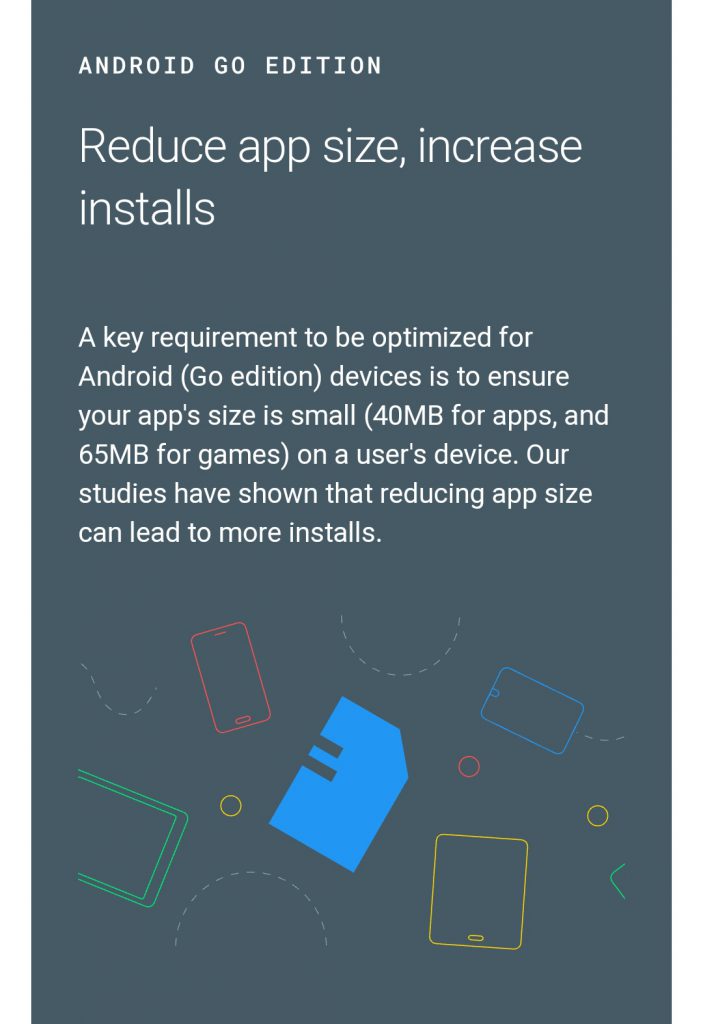Two variants of #Redmi5A #DeshKaSmartphone:
— Manu Kumar Jain (@manukumarjain) November 30, 2017
* 2GB RAM + 16GB storage: Priced at ₹ 4,999 for the first 5 million units, post which it will be available for ₹ 5,999.
* 3GB RAM + 32GB storage: Priced at ₹ 6,999.
RT if you think 4,999 is a truly revolutionary price! pic.twitter.com/X4Mh4czwpB
The Android Go initiative from Google is somewhat confusing from its inception. The Mountain View tech giant came with a ‘theoretically’ brilliant idea to make a tailored distribution of regular Android for low-end devices.

Google’s definition of ‘low-end’ points towards devices with 1 GB of RAM or less. This special version of Android has several platform optimizations designed to reduce mobile data usage.
For example, the Data Saver mode is turned on by default. Go edition also features a slimmed down version of Google Mobile Services designed to be less resource- and bandwidth-intensive.

Unlike Android One, OEMs have more freedom to customize the Android Go firmware. Keeping the stock Android interface is optional, thus manufactures can put their skins on top of the Go certified distribution.
On the other hand, the Chinese manufacturers (especially Xiaomi) have already set a new benchmark in performance/price ratio. Xiaomi’s Redmi A series phones (e.g. Redmi 5A) can easily deliver a capable entry level SoC with 2/3 GB RAM and 16/32 GB internal storage, well under ₹6,000 (~$90).
The entry level phone segment is the primary target of Android Go initiative. The problem is, smartphone makers can not opt for Go optimizations on devices having greater than 1 GB RAM. Moreover, it is virtually impossible to compete against the OEMs like Xiaomi, who are offering better specs under same, or even lesser price tag.
The situation became more convoluted, when Redmi (now an independent brand) announced their first Android Go phone – the Redmi Go.

Thanks to the leaked press releases, we came to know about the existence of the phone way before official announcement.
Here's your first look at the Xiaomi Redmi Go, the upcoming Android Go Smartphone. Click on the images below to see full resolution renders and full specs of the upcoming smartphone, launching soon in India! (First spotted by https://t.co/Jha1L96xJX ).#RedmiGO#Redmi#Xiaomi pic.twitter.com/nf6LX4yAOP
— Ishan Agarwal (@ishanagarwal24) January 24, 2019
As you can see, the phone is not a power house. Rather, it’s more of a ‘get things done’ type. The initial target markets are developing countries from Africa and south-east Asia, although official European release is in the pipeline.
Redmi Go, muncul pertama kali di @JDid jam 10 pagi ini ya guys. Yang udah niat beliin orang tersayang bisa langsung kesini -> https://t.co/vP31eCfwEZ#mendingresMI #RedmiGo pic.twitter.com/zyYCbxBDim
— Redmi Indonesia #MiFan (@RedmiIndonesia) March 11, 2019
Speed. Power. Size. Flash. The #RedmiGo has something for everyone. Comment with your favorite feature! #GoSmartDoMore
— Xiaomi Kenya - #RedmiNote10Series (@Xiaomi_Kenya) March 13, 2019
https://t.co/GIJsrYPlQB pic.twitter.com/PEjCbqTk2i
I like to call it a conflict of interest. Xiaomi’s upcoming Redmi 7A would be a direct competitor of Redmi Go in the price segment (KSh 8,499 => ~$85), while giving way better performance.
Have your own cinema in your hand. Never worry about running low with Redmi Go 3000mAh Durable battery. Available at Banana Phone World, Simba Telecom Limited, Mr Gadget, Mercury Computers Limited, Millennium Exclusive, Jubilee Appliances, Login computers & Kings Infosys Outlets. pic.twitter.com/gwoeolgZR8
— Xiaomi (MI) Uganda (@XiaomiMIUganda) March 12, 2019
It was initially speculated that Xiaomi would launch the budget oriented Redmi Go alongside Redmi Note 7 and Redmi Note 7 Pro in India. Well, the myth was debunked by none other than Manu Kumar Jain, Global VP of Xiaomi.
OMG! How do you know sir? 😎
— Manu Kumar Jain (@manukumarjain) February 26, 2019
Well, there is defintely one thing that is wrong.. No, we are not using SD 636! We are using my favourite processor - SD 625! 😉😁
-----
Jokes aside, request all to follow our official channels for correct information. 🙏#RedmiNote7: 28th Feb! https://t.co/8tqYqahI6Z
Thanks to developer yshalsager and his wonderful Xiaomi Firmware Updater project, we have spotted several firmware packages for Redmi Go (codename: tiare). Among them, one is particularly interesting – it’s intended for India!
- Device: Redmi Go
- Codename: tiare
- Channel: Global (India) Stable
- Version: V10.2.7.0.OCLINXM
- Android: 8.1
- Type: Recovery
- Download: Link
- MD5: b75f0b77d98900312a5f70c0820da48f
- Type: Recovery
Yes, they are planning to ship with Android 8.1 Oreo while the first beta of Android Q is here.
The phone may get Android 9 Pie update in future, but don’t take my word for it. Google reportedly had faced some quirks to shape up Pie for Android Go devices.
After internal testing, and extended discussions with some of the manufacturers’ engineering teams, Google understood these regressions stem from some of the graphics improvements developers made for the higher end devices.
Google is beefing up their steps to ensure such performance impacting changes are caught well in advance on the low-end devices in the future Android releases. As such, Google will be extending the GMS approval window for Android Go on Android 8 (Oreo) to October 31, 2019.
The size of the recovery zip is less than 1 GB (~750 MB), which is possible because of the small app sizes and Android Go restrictions.

Question to Indian readers, are you planning to buy the first Android Go phone from Xiaomi? Let us know by commenting below.
PiunikaWeb is a unique initiative that mainly focuses on investigative journalism. This means we do a lot of hard work to come up with news stories that are either ‘exclusive,’ ‘breaking,’ or ‘curated’ in nature. Perhaps that’s the reason our work has been picked by the likes of Forbes, Foxnews, Gizmodo, TechCrunch, Engadget, The Verge, Macrumors, and more. Do take a tour of our website to get a feel of our work. And if you like what we do, stay connected with us on Twitter (@PiunikaWeb) and other social media channels to receive timely updates on stories we publish.


